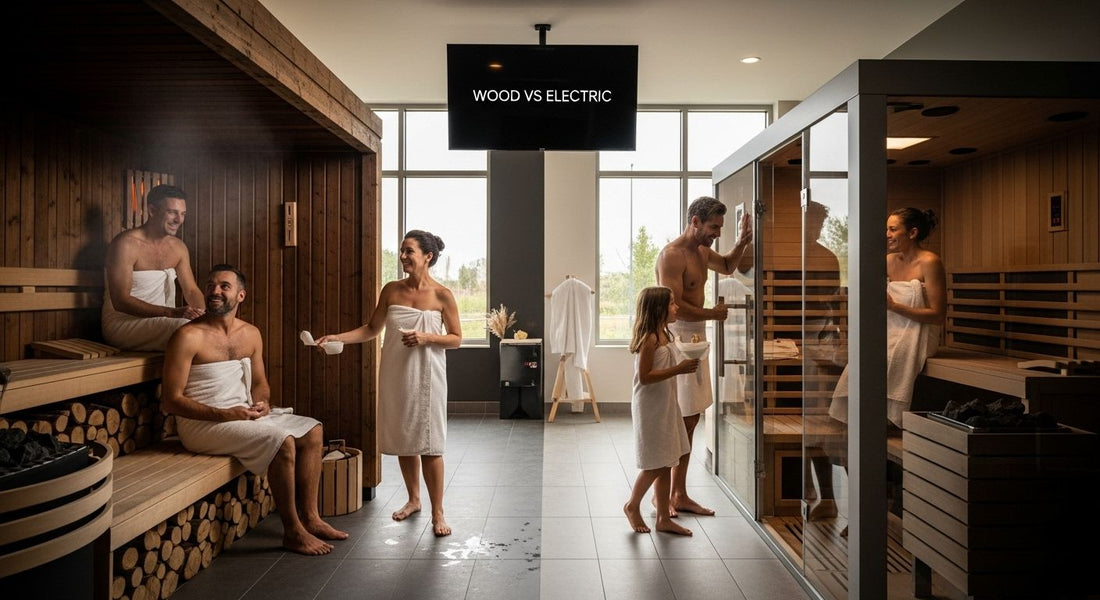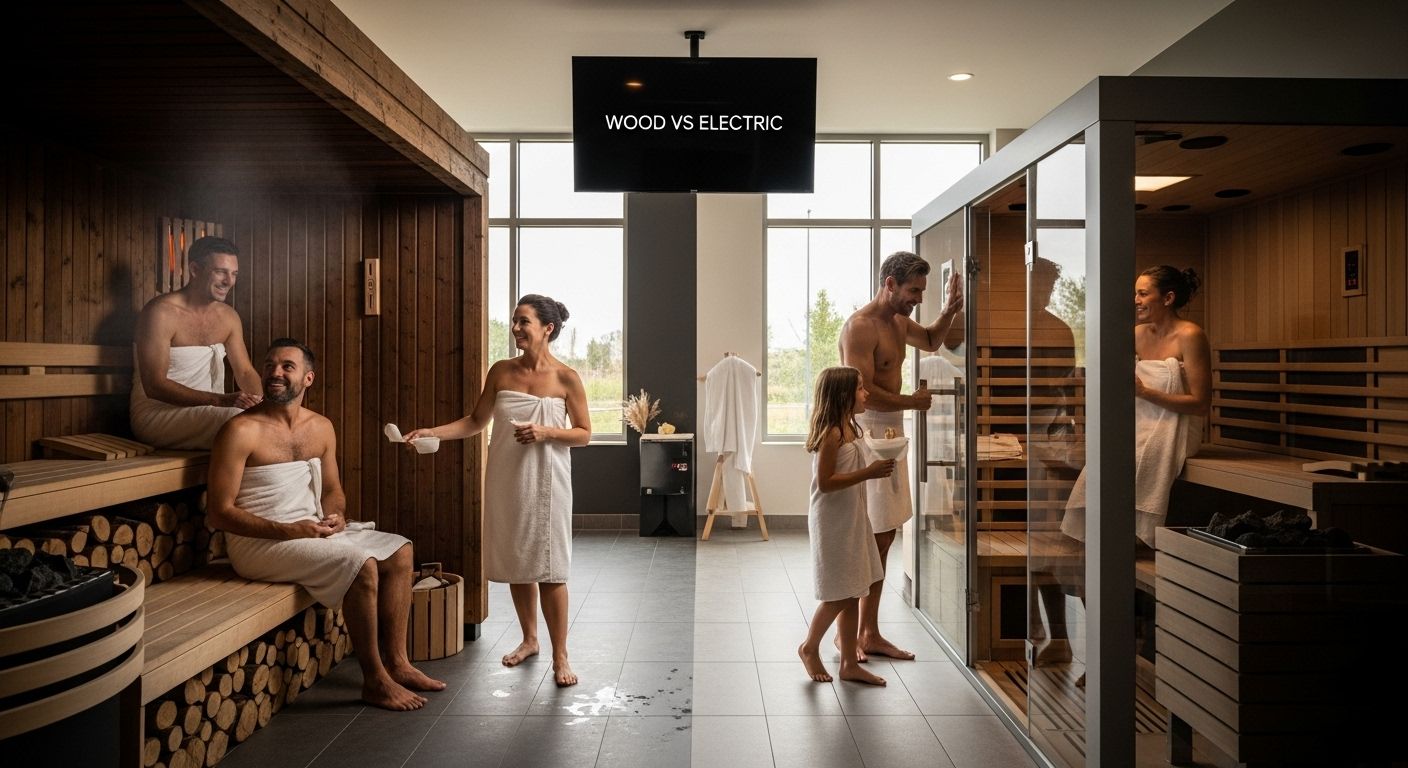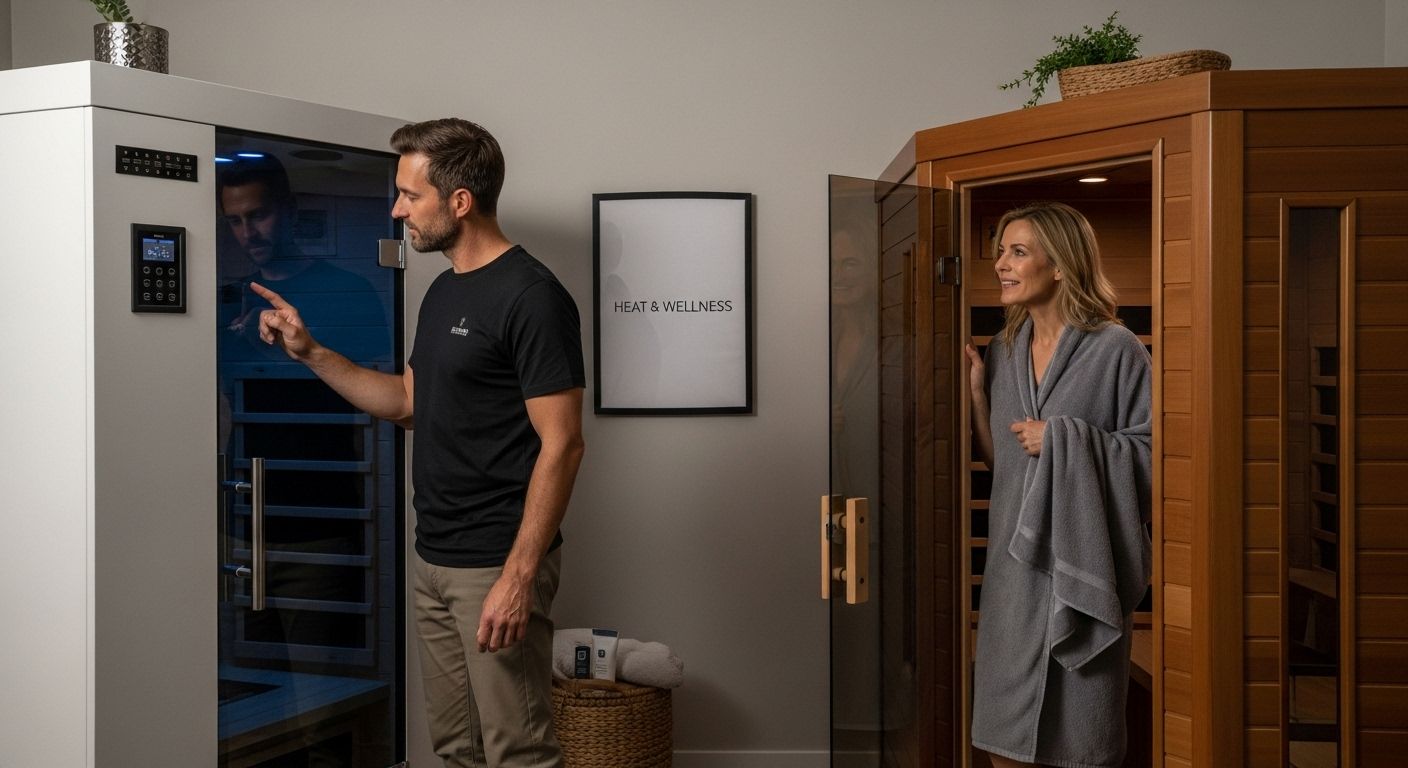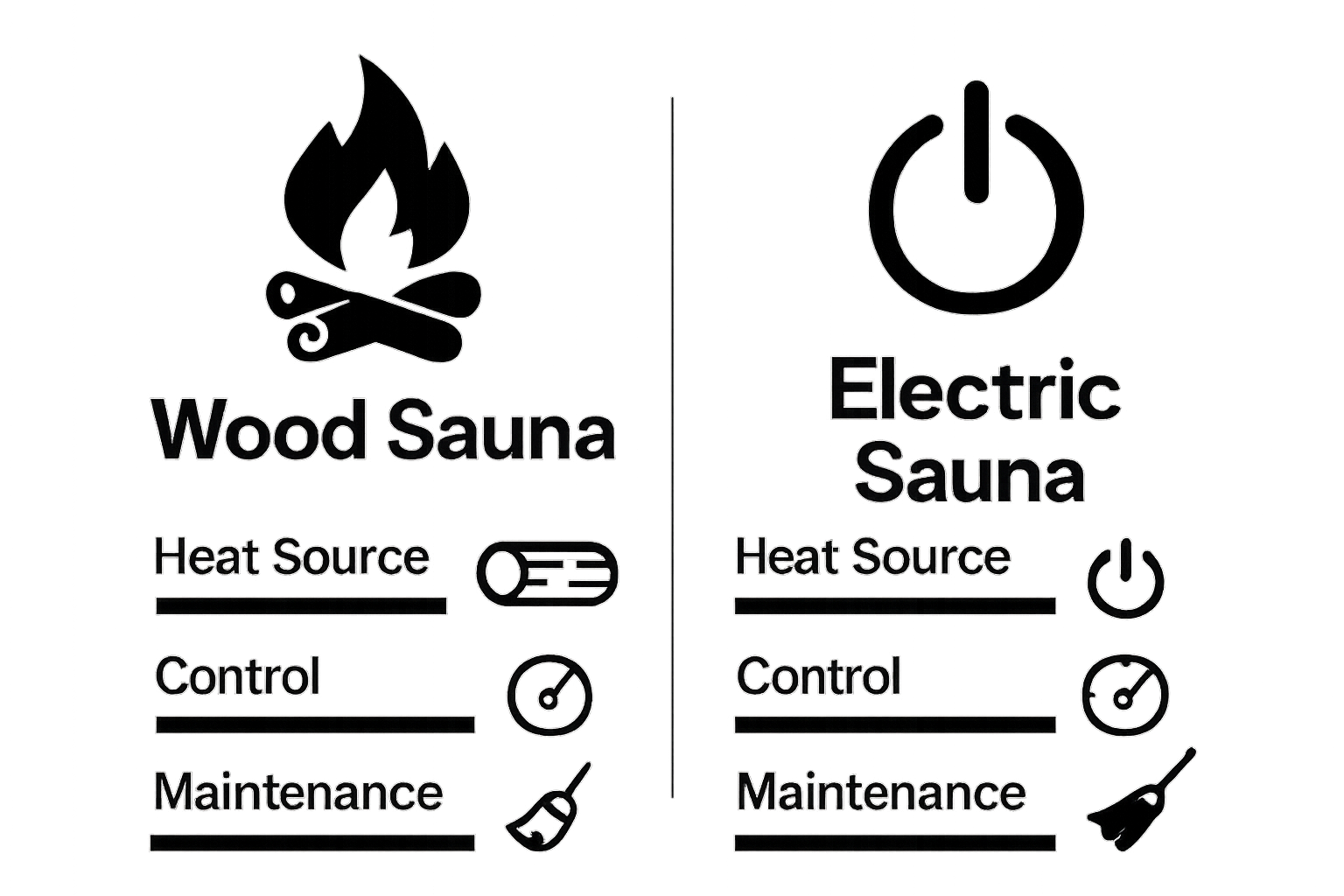
Understanding Wood vs Electric Sauna: Key Differences Explained

Wood and electric saunas have exploded in popularity across North America, with the outdoor sauna market alone expected to reach over 200 million dollars by 2026. Most people think the main difference is just a matter of how they get hot. That could not be further from the truth. The real surprise lies in how each type uniquely impacts your body, your mind, and even your home experience.
Table of Contents
- What Is A Wood Sauna And How Does It Work?
- What Is An Electric Sauna And How Does It Work?
- Key Benefits Of Using A Wood Sauna
- Key Benefits Of Using An Electric Sauna
- Choosing The Right Sauna For Your Wellness Needs
Quick Summary
| Takeaway | Explanation |
|---|---|
| Wood saunas enhance cardiovascular health. | The high temperatures stimulate blood circulation and improve heart function, contributing to overall cardiovascular wellness. |
| Electric saunas offer precise temperature control. | Users can set specific temperatures, ensuring consistent heat that enhances comfort and therapeutic benefits without manual effort. |
| Both sauna types support mental wellness. | Regular sessions in either sauna can reduce stress, boost mood, and foster a sense of relaxation, promoting overall mental health. |
| Choose based on health goals and lifestyle. | Assess personal wellness needs, space availability, and maintenance preferences to find the sauna that best fits your lifestyle. |
| Wood saunas provide a sensory experience. | The traditional wood-burning method offers an aromatic and immersive environment that enhances relaxation and overall well-being. |
What is a Wood Sauna and How Does It Work?
A wood sauna represents a traditional form of heat therapy that has roots in ancient Nordic and Finnish wellness practices. Unlike modern electric alternatives, wood saunas use burning wood as their primary heat source, creating a unique sensory experience that connects users with a more primitive and natural relaxation method.
The Traditional Heating Mechanism
Wood saunas operate through a fundamental heating principle involving a wood-burning stove called a “kiuas” in Finnish. This stove typically contains stones that absorb and radiate heat, creating an environment where temperatures can range between 150 to 195 degrees Fahrenheit. When water is carefully ladled over these heated stones, it produces steam called “löyly,” which intensifies the heat and humidity, providing a profound sweating experience.
The heating process in a wood sauna involves several key elements:
- Direct heat generation through burning wood
- Stone-based heat retention and distribution
- Controlled humidity through manual water application
- Natural thermal regulation
Construction and Materials
Traditional wood saunas are typically constructed using specific wood types that can withstand high temperatures and provide excellent insulation. Cedar, hemlock, and spruce are popular choices due to their natural resistance to moisture and ability to maintain consistent temperatures. The wooden interior not only serves a functional purpose but also creates an aromatic environment that enhances the overall sensory experience.
According to National Library of Medicine, wood saunas offer more than just heat therapy. They represent a holistic wellness practice that can improve cardiovascular function, reduce stress, and support overall mental and physical recovery. The combination of controlled heat, steam, and the natural wooden environment creates a unique therapeutic space that goes beyond simple temperature regulation.
What is an Electric Sauna and How Does It Work?
An electric sauna represents a modern approach to heat therapy, utilizing electrical heating elements to create a controlled, consistent thermal environment. Unlike traditional wood-fired saunas, electric saunas offer precise temperature management and convenient operation, making them increasingly popular in residential and commercial wellness spaces.
Electrical Heating Technology
Electric saunas function through specialized heating elements typically mounted on walls or as standalone units. These electrical components convert electrical energy directly into radiant heat, warming the sauna space quickly and efficiently. The heating mechanism allows users to set exact temperatures ranging between 120 to 195 degrees Fahrenheit, providing a customizable experience that traditional wood saunas cannot match.
Key technological features of electric sauna heating include:
- Rapid heat generation within minutes
- Precise digital temperature control
- Even heat distribution throughout the space
- Energy-efficient electrical components
- Simple on/off switching mechanisms
Design and Installation Considerations
Modern electric saunas come in various design configurations, from portable units to built-in room installations. These saunas can be constructed using heat-resistant materials like cedar, hemlock, or specially treated woods that can withstand consistent high temperatures. The electrical components are carefully integrated to ensure safety and optimal performance, with most units featuring built-in circuit protection and temperature limit controls.
According to Harvard Health Publishing, electric saunas provide consistent heat therapy that can support cardiovascular health, reduce stress, and promote overall wellness. The technology allows for a controlled environment where users can experience therapeutic heat without the manual maintenance required by wood-burning alternatives.
Key Benefits of Using a Wood Sauna
Wood saunas offer a remarkable range of health and wellness benefits that extend far beyond simple heat exposure. The traditional heating method creates a unique therapeutic environment that supports physical recovery, mental relaxation, and holistic well-being through natural, time-tested mechanisms.
Physical Health Advantages
The intense heat generated by wood saunas triggers multiple physiological responses that contribute to overall health. When exposed to high temperatures, the body initiates a natural cooling mechanism through sweating, which helps eliminate toxins, improve circulation, and support metabolic functions. The combination of dry heat and optional steam creates a powerful detoxification process that can enhance cardiovascular performance and muscle recovery.
Significant physical health benefits include:
- Enhanced cardiovascular system performance
- Improved blood circulation
- Natural detoxification through increased sweating
- Muscle tension reduction
- Potential boost to immune system function
Mental Wellness and Stress Reduction
Beyond physical benefits, wood saunas provide profound mental health advantages. The immersive heat experience creates a meditative environment that allows users to disconnect from daily stressors. The rhythmic process of heat exposure and controlled cooling triggers the release of endorphins, promoting relaxation and reducing anxiety. Traditional sauna practices have long been recognized as a form of mental reset, offering a sanctuary for mental clarity and emotional balance.
According to Harvard Health Publishing, regular sauna sessions can significantly contribute to stress reduction and overall mental well-being. The controlled heat environment acts as a natural therapeutic space that supports both physical recovery and psychological relaxation, making wood saunas a holistic wellness practice deeply rooted in traditional health techniques.
Key Benefits of Using an Electric Sauna
Electric saunas represent a modern wellness solution that delivers targeted health benefits through precise temperature control and advanced heating technology. By leveraging electrical heating elements, these saunas create a consistent therapeutic environment that supports comprehensive physical and mental wellness.
Physical Performance and Recovery
The controlled heat environment of electric saunas offers significant advantages for physical recovery and performance optimization. Exposure to consistent high temperatures stimulates cardiovascular responses similar to moderate exercise, promoting improved blood circulation and metabolic function. The ability to maintain exact temperatures allows users to customize their heat therapy experience, supporting muscle relaxation, reducing joint stiffness, and enhancing overall physical recovery.
Key physical performance benefits include:
- Enhanced cardiovascular system stimulation
- Accelerated muscle recovery processes
- Improved metabolic rate and circulation
- Reduced muscle and joint inflammation
- Potential support for pain management
Mental Wellness and Stress Management
Electric saunas provide a reliable mechanism for mental relaxation and stress reduction. The predictable heat environment creates a meditative space where individuals can disconnect from external stimuli and focus on personal restoration. The consistent warmth triggers neurological responses that promote endorphin release, helping to alleviate anxiety, improve mood, and support overall mental well-being.
According to Mayo Clinic Proceedings, regular sauna sessions are associated with significant reductions in cardiovascular and neurological health risks. The controlled electric sauna environment offers a scientifically supported approach to wellness that combines technological precision with traditional heat therapy principles, making it an effective tool for holistic health maintenance.

Choosing the Right Sauna for Your Wellness Needs
Selecting the appropriate sauna involves carefully evaluating personal wellness goals, spatial constraints, and individual preferences. The decision between wood and electric saunas requires understanding the unique characteristics, benefits, and potential limitations of each heating approach to ensure an optimal wellness experience.
Personal Health and Lifestyle Considerations
The selection process begins with a comprehensive assessment of individual health objectives and lifestyle dynamics. Wood saunas appeal to those seeking a traditional, immersive experience with natural heat generation, while electric saunas offer precise technological control and convenience. Factors such as existing health conditions, available space, maintenance capabilities, and personal comfort with different heat technologies play crucial roles in making an informed decision.
Key selection criteria include:

- Personal health and fitness goals
- Available installation space
- Budget and long-term maintenance requirements
- Desired heat intensity and control preferences
- Compatibility with existing home infrastructure
Technical and Practical Evaluation
Beyond subjective preferences, technical aspects demand careful consideration. Electric saunas provide consistent temperature management and easier installation, making them ideal for indoor spaces and users prioritizing convenience. Wood saunas offer a more authentic experience with potential aromatic benefits and a connection to traditional wellness practices. Installation complexity, energy efficiency, operational costs, and potential home value enhancement should be thoroughly evaluated.
According to the North American Sauna Society, understanding the nuanced differences between sauna types is essential for making an informed wellness investment. The right sauna selection transcends mere heating technology, representing a personalized approach to health, relaxation, and holistic well-being that aligns with individual lifestyle needs and preferences.
To help readers easily compare wood and electric saunas, the following table summarizes their key features, benefits, and considerations based on content from the article.
| Feature | Wood Sauna | Electric Sauna |
|---|---|---|
| Heat Source | Wood-burning stove (kiuas) | Electric heating elements |
| Temperature Control | Manual, based on wood amount and airflow | Precise digital control |
| Heating Speed | Slower, requires time to heat up | Rapid, heats within minutes |
| Humidity | Steam added by pouring water on stones | Can add steam manually, but typically drier |
| Sensory Experience | Aromatic wood scent, traditional ambiance | Consistent, modern, less aromatic |
| Installation | Requires chimney/ventilation, more complex | Easier, requires only electrical setup |
| Maintenance | Ash disposal, wood storage, stove cleaning | Little ongoing maintenance |
| Best For | Authentic tradition seekers, nature connection | Those who want convenience and controllable temperature |
Bring Authentic Sauna Wellness Home With Confidence
Choosing between a traditional wood sauna and a modern electric sauna is a big decision. This article explains the key differences and highlights how your sauna should match your health goals and lifestyle. If you are looking for a deeply relaxing, holistic sauna experience or you want precise temperature control and easy maintenance, your needs deserve personalized solutions. Stress relief, improved circulation, and enhanced recovery are possible when you have the right system at home.

Experience the benefits for yourself and explore a wide selection of premium wood and electric saunas at Best Life Sauna. See how our sauna collections and wellness accessories combine advanced technology with time-honored traditions to transform your self-care routine. Visit our main page now and take advantage of our price match guarantee and free shipping offers. Make a lasting investment in your health and enjoy the satisfaction of expert customer support every step of the way.
Frequently Asked Questions
What are the main differences between wood and electric saunas?
Wood saunas use a wood-burning stove for heat, creating a natural and immersive experience, while electric saunas utilize electric heating elements for quick and precise temperature control.
How do wood saunas generate heat?
Wood saunas generate heat through the burning of wood in a stove called a “kiuas,” which heats stones that store and radiate heat. Water poured over the stones creates steam, enhancing the sauna experience.
Can I customize the temperature in an electric sauna?
Yes, electric saunas offer precise temperature control, allowing users to set temperatures between 120 to 195 degrees Fahrenheit for a tailored sauna experience.
What health benefits are associated with using a sauna?
Both wood and electric saunas provide numerous health benefits, such as improved cardiovascular function, stress reduction, muscle relaxation, and detoxification through sweating.

